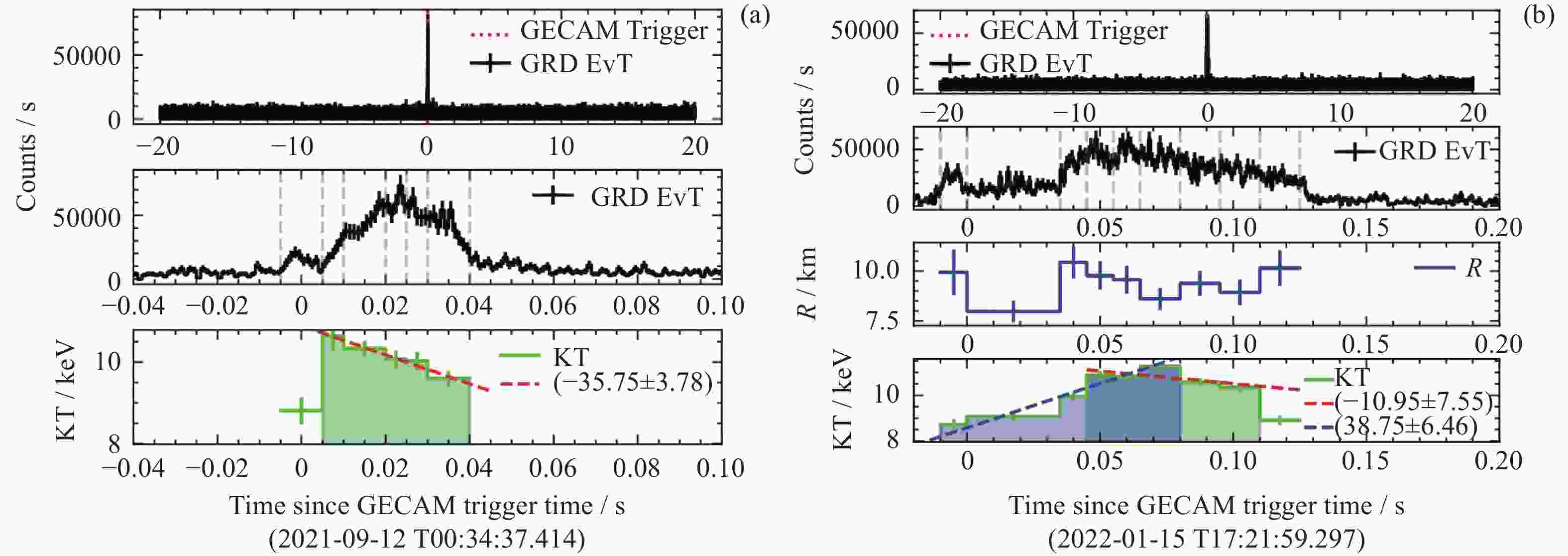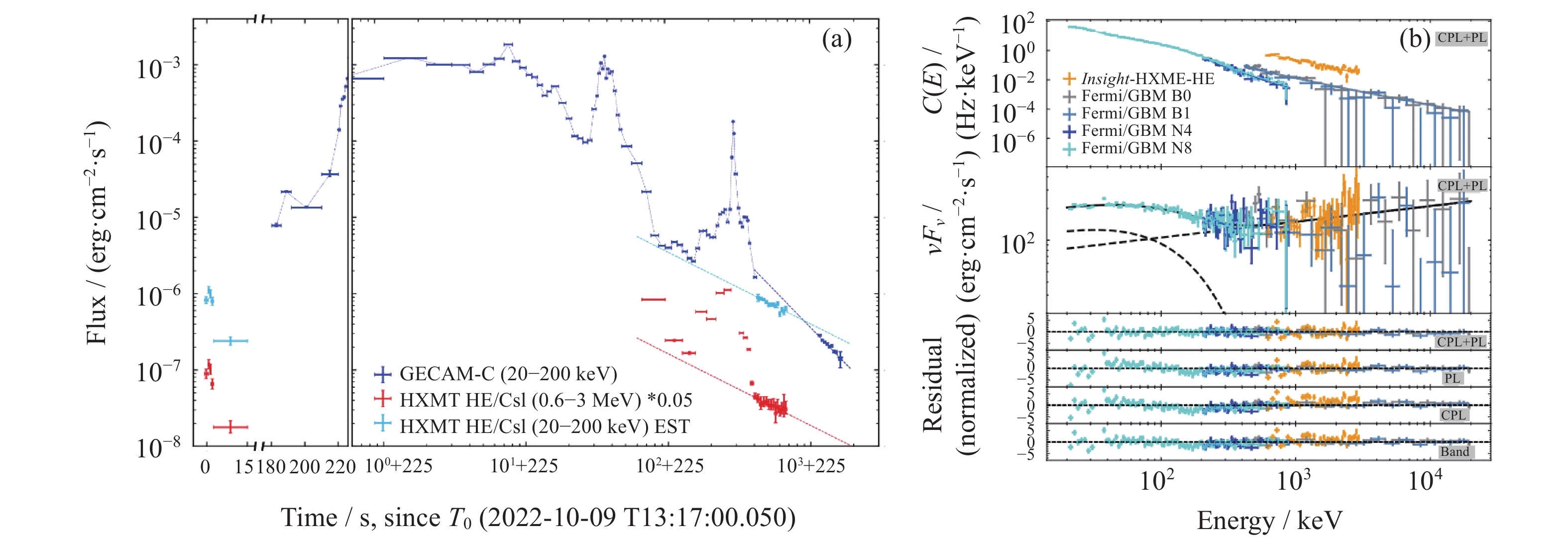Progress of GECAM Observation Research
doi: 10.11728/cjss2024.04.2024-yg13 cstr: 32142.14.cjss2024.04.2024-yg13
-
Abstract: Gravitational wave high-energy Electromagnetic Counterpart All-sky Monitor (GECAM) is a constellation with four instruments (launch date): GECAM-A/B (10 December 2020), GECAM-C (27 July 2022) and GECAM-D (13 March 2024), which are dedicated to monitoring gamma-ray transients in all-sky. The primary science objectives of GECAM include Gamma-Ray Bursts (GRBs), Soft Gamma-ray Repeaters (SGRs), high energy counterparts of Gravitation Wave (GW) and Fast Radio Burst (FRB), Solar Flares (SFLs), as well as Terrestrial Gamma-ray Flashes (TGFs) and Terrestrial Electron Beams (TEBs). A series of observations and research have been made since the launch of GECAM-A/B. GECAM observations provide new insights into these high-energy transients, demonstrating the unique role of GECAM in the “multi-wavelength, multi-messenger” era.
-
Figure 2. Light curves and the evolution of the Blackbody Temperature (KT) with time of two bursts from SGR J1935+2154[9]: trigger time of burst is 2021-09-12T00:34:37.414 for panel (a) and 2022-01-15T17:21:59.297 for panel (b)
Figure 3. Geographical distribution of GECAM TGFs, including 147 TGFs (red pluses), 2 TEBs (green circles) and 2 TEB-like events (blue triangles). The green dashed lines show the east Asia region while the orange dashed lines represent the South Atlantic Anomaly (SAA)[14]
-
[1] ABBOTT B P, ABBOTT R, ABBOTT T D, et al. Gravitational waves and gamma-rays from a binary neutron star merger: GW170817 and GRB 170817A[J]. The Astrophysical Journal Letters, 2017, 848(2): L13 doi: 10.3847/2041-8213/aa920c [2] AN Z H, ANTIER S, BI X Z, et al. Insight-HXMT and GECAM-C observations of the brightest-of-all-time GRB 221009A[OL]. arXiv preprint arXiv: 2303.01203, 2023. DOI:10.48550/arXiv.2303.01203 [3] ZHENG C, ZHANG Y Q, XIONG S L, et al. Observation of GRB 221009A early afterglow in X-Ray/gamma-ray energy bands[J]. The Astrophysical Journal Letters, 2024, 962(1): L2 doi: 10.3847/2041-8213/ad2073 [4] ZHANG Y Q, XIONG S L, MAO J R, et al. Observation of spectral lines in the exceptional GRB 221009A[J]. Science China Physics, Mechanics & Astronomy, 2024, 67 (8): 289511 [5] YANG J, ZHAO X H, YAN Z Y, et al. Synchrotron radiation dominates the extremely bright GRB 221009A[J]. The Astrophysical Journal Letters, 2023, 947(1): L11 doi: 10.3847/2041-8213/acc84b [6] SUN H, WANG C W, YANG J, et al. Magnetar emergence in a peculiar gamma-ray burst from a compact star merger[OL]. arXiv preprint arXiv: 2307.05689, 2023. DOI: 10.48550/arXiv.2307.05689 [7] YI S X, WANG C W, SHAO X Y, et al. Evidence of mini-jet emission in a large emission zone from a magnetically-dominated gamma-ray burst jet[OL]. arXiv preprint arXiv: 2310.07205, 2023. DOI: 10.48550/arXiv.2310.07205 [8] XIE S L, CAI C, XIONG S L, et al. Revisit the periodicity of SGR J1935+2154 bursts with updated sample[J]. Monthly Noti ces of the Royal Astronomical Society, 2022, 517(3): 3854-3863 doi: 10.1093/mnras/stac2918 [9] XIAO S, TUO Y L, ZHANG S N, et al. Discovery of the linear energy dependence of the spectral lag of X-ray bursts from SGR J1935+2154[J]. Monthly Notices of the Royal Astronomical Society, 2023, 521(4): 5308-5333 doi: 10.1093/mnras/stad885 [10] XIAO S, YANG J J, LUO X H, et al. The minimum variation timescales of X-ray bursts from SGR J1935+2154[J]. The Astrophysical Journal Supplement Series, 2023, 268(1): 5 doi: 10.3847/1538-4365/ace77c [11] XIAO S, LI X B, XUE W C, et al. Individual and averaged power density spectra of X-ray bursts from SGR J1935+2154: quasi-periodic oscillation search and slopes[J]. Monthly Notices of the Royal Astronomical Society, 2024, 527(4): 11915-11924 [12] XIAO S, ZHANG S N, XIONG S L, et al. The self-organized criticality behaviours of two new parameters in SGR J1935+2154[J]. Monthly Notices of the Royal Astronomical Society, 2024, 528(2): 1388-1392 doi: 10.1093/mnras/stae142 [13] ZHAO H S, LI D, XIONG S L, et al. Paired quasi-periodic pulsations of hard X-ray emission in a solar flare[J]. Science China Physics, Mechanics & Astronomy, 2023, 66 (5): 259611 [14] ZHAO Y, LIU J C, XIONG S L, et al. The first GECAM observation results on terrestrial gamma-ray flashes and terrestrial electron beams[J]. Geophysical Research Letters, 2023, 50(14): e2022GL102325 doi: 10.1029/2022GL102325 -
-






 下载:
下载:





